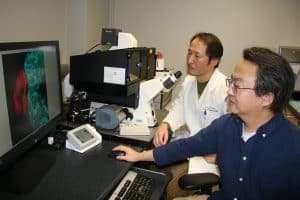Researcher Reveals Clues to Immunity as a Cause of High Blood Pressure
| Feb. 8, 2017 | A University of Arkansas for Medical Sciences (UAMS) researcher has shed light on the role of immune cells inside the kidneys in the development of salt-sensitive high blood pressure, publishing his findings in Nature Communications.
Shengyu Mu, Ph.D., assistant professor in the Department of Pharmacology and Toxicology in the UAMS College of Medicine, and his colleagues used innovative techniques, including super-resolution microscopy in UAMS’ Digital Microscopy Core, to illustrate at cellular and molecular levels that activation of immune cells in the kidneys can result in salt-sensitive high blood pressure, which is a form of high blood pressure that reacts directly to salt intake.
“High blood pressure is very common, and this salt-sensitive version is present in about 40-50 percent of cases of hypertension initially and becomes worse as the disease progresses,” Mu said. “For many years, the recommendation for heart health has been to eat less salt. But studies have shown that while it does lower blood pressure; too little salt also increases the rate of cardiovascular events and mortality in patients, which is all the more reason for us to develop a better understanding of the causes of salt-sensitivity.”

From left, Sung W. Rhee, Ph.D.; and Shengyu Mu, Ph.D., of the UAMS Department of Pharmacology and Toxicology review images taken by super-resolution microscopy in UAMS’ Digital Microscopy Core.
Specifically, Mu’s work uncovered the interaction of a particular type of white blood cell with kidney cells. Scientists suspected that these cells – T lymphocytes, or T cells – played a role in developing high blood pressure but scientists were not sure how.
Mu demonstrated that too many T cells in the kidneys might be the cause of salt sensitivity of high blood pressure. A major subtype of these T cells interacts directly with – and actually touches – the cells located in the area of the kidneys that reabsorb salt. This process enhances sodium chloride absorption in the kidney, thereby impairing the function of the kidneys that filter out excessive salt, consequently leading to salt-sensitive high blood pressure.
“Dr. Mu is doing important work and we are thrilled to have it recognized with this publication in the prestigious journal Nature Communications, which is an acknowledgment of his diligent dedication to improving our scientific understanding in this area,” said Nancy J. Rusch, Ph.D., professor and chair of the Department of Pharmacology and Toxicology.
Before coming to UAMS in 2013, Mu received his medical degree from TianJin Medical University in China and a Ph.D. from the University of Tokyo in Japan. Salt-sensitivity and high blood pressure have been Mu’s area of research for his entire career. Previously, his work has been published in Nature Medicine and the Journal of Clinical Investigation. He recently received the New Investigator award and the Research Recognition award from the American Heart Association and the American Physiology Society for his contributions to research.
“It definitely means a lot to me to have my work published in a high quality journal,” Mu said. “It’s a confirmation of the direction of my work in the last few years since coming to UAMS and the findings provide a foundation for us to move forward to strengthen our understanding of this condition.”
Mu is preparing to publish additional findings from this round of research and is writing grants for follow-up pursuits. He would like to explore how exactly the T cells and kidney cells are binding together.
“I’d also like to study the ‘why’ behind the amplified effect of this binding of T cells and kidney cells that causes retention of salt in the body. We all have these cells, so what causes this amplified effect in people who get salt-sensitive high blood pressure?” Mu said.
Additional authors on the paper from UAMS include Sung W. Rhee, Ph.D., associate professor in the Department of Pharmacology and Toxicology; postdoctoral fellow Yunmeng Liu; and technicians Tonya M. Rafferty, Jessica S. Webber, Li Song and Beixiang He.
The work was funded by a Beginning Grant-in-Aid from the American Heart Association as well as UAMS Foundation Fund and departmental support.
The Comprehensive Microscope Imaging Center was constructed at UAMS in 2011 and houses UAMS’ state-of-the-art microscope technologies under one roof.
Nature Communications is a leading open-access multidisciplinary journal that is part of the Nature Research portfolio of products and services across the life, physical, chemical and applied sciences, including journals, online databases and researcher services, which are dedicated to serving the scientific community. The flagship publication Nature was founded in 1869 and is the leading weekly, international scientific journal.
UAMS is the state’s only health sciences university, with colleges of Medicine, Nursing, Pharmacy, Health Professions and Public Health; a graduate school; a hospital; a main campus in Little Rock; a Northwest Arkansas regional campus in Fayetteville; a statewide network of regional campuses; and eight institutes: the Winthrop P. Rockefeller Cancer Institute, Jackson T. Stephens Spine & Neurosciences Institute, Harvey & Bernice Jones Eye Institute, Psychiatric Research Institute, Donald W. Reynolds Institute on Aging, Translational Research Institute, Institute for Digital Health & Innovation and the Institute for Community Health Innovation. UAMS includes UAMS Health, a statewide health system that encompasses all of UAMS’ clinical enterprise. UAMS is the only adult Level 1 trauma center in the state. UAMS has 3,275 students, 890 medical residents and fellows, and five dental residents. It is the state’s largest public employer with more than 12,000 employees, including 1,200 physicians who provide care to patients at UAMS, its regional campuses, Arkansas Children’s, the VA Medical Center and Baptist Health. Visit www.uams.edu or uamshealth.com. Find us on Facebook, X (formerly Twitter), YouTube or Instagram.###
